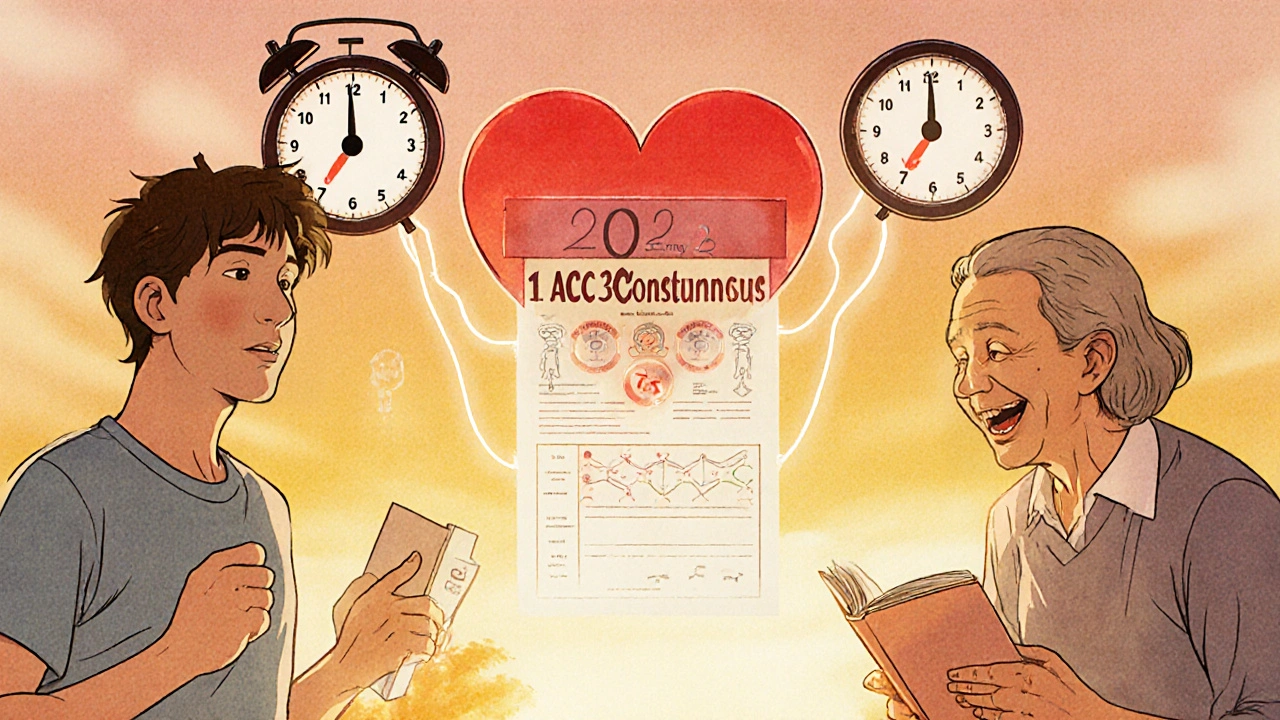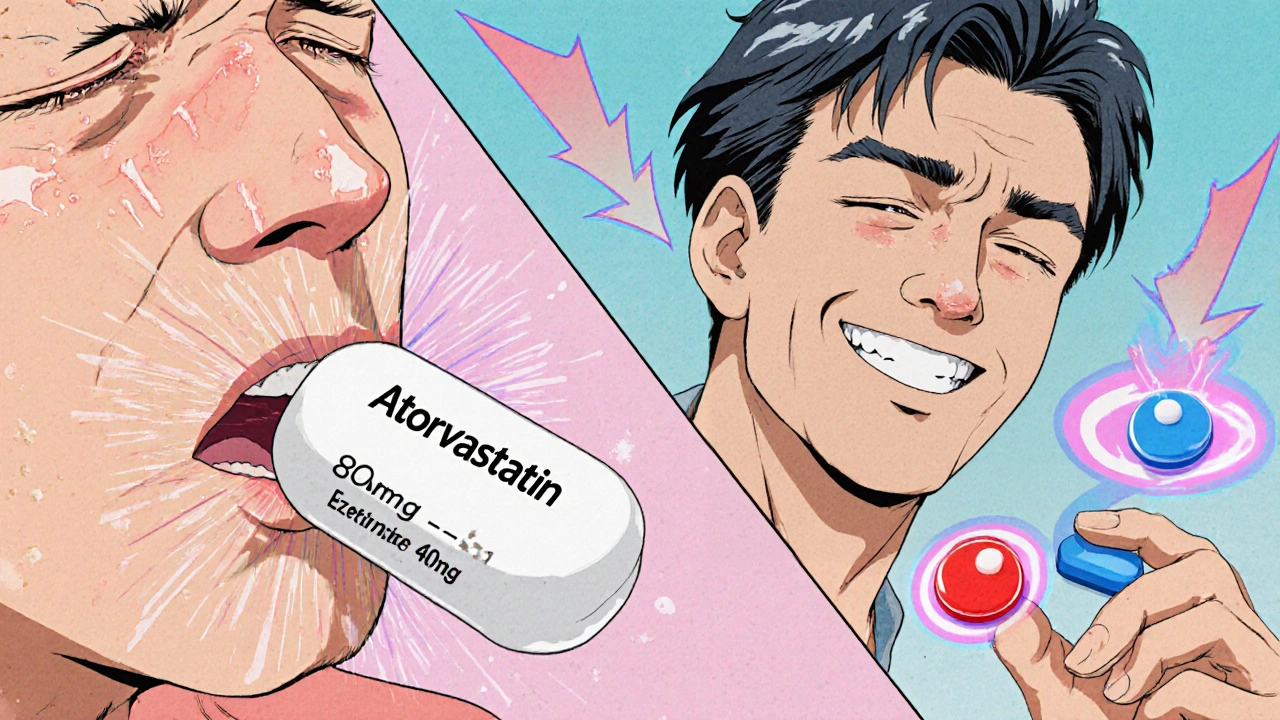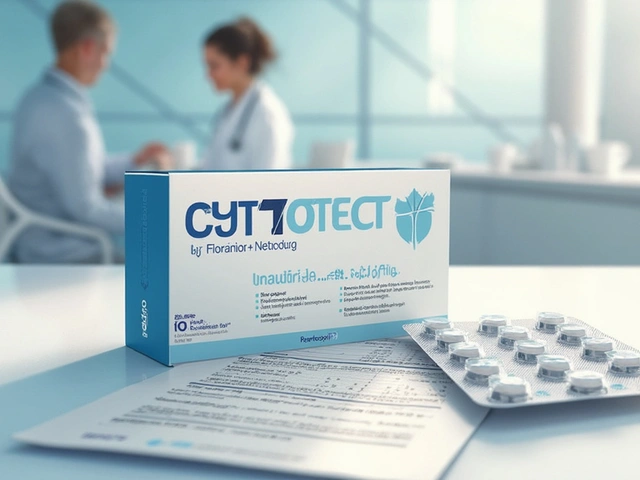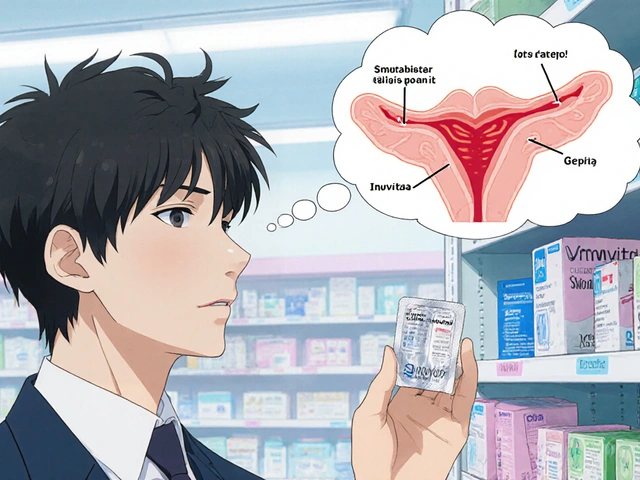Cholesterol Reduction Calculator
Cholesterol Treatment Calculator
Treatment Options Comparison
Required LDL Reduction
To reach your target of 0 mg/dL from 0 mg/dL, you need 0% reduction
Continue Current Statin
Typical LDL reduction: 30-49%
Double Statin Dose
Typical LDL reduction: 50-55%
Combination Therapy
Typical LDL reduction: 50-55%
For years, doctors have reached for higher doses of statins when patients’ LDL cholesterol won’t drop low enough. But here’s the truth: increasing statin dose doesn’t work the way most people think. Doubling the dose doesn’t double the effect. In fact, it barely moves the needle. A 2023 analysis in the Journal of the American College of Cardiology showed that going from 10mg to 20mg of atorvastatin only adds about 6% more LDL reduction. That’s the rule of six - and it’s why so many patients still aren’t hitting their targets, even on high doses.
Why High-Dose Statins Fall Short
High-intensity statins like atorvastatin 80mg or rosuvastatin 40mg are often prescribed for people with heart disease, diabetes, or very high cholesterol. But up to 15% of patients can’t tolerate them. Muscle aches, fatigue, or elevated liver enzymes lead to discontinuation - and in some cases, up to half of patients stop taking statins within a year. That’s not just a compliance issue. It’s a public health problem. People with a history of heart attack or stroke need their LDL below 55 mg/dL. If they’re off their meds, their risk stays high. The problem isn’t just side effects. Even in patients who stick with high-dose statins, many still don’t reach target levels. One study found that only 62% of high-risk patients hit their LDL goal on high-intensity statin monotherapy. That leaves nearly 4 in 10 at serious risk.The Power of Combining Therapies
The solution isn’t more statin. It’s smarter statin - paired with a second agent. Combination therapy uses a moderate dose of statin (like atorvastatin 20mg or rosuvastatin 10mg) plus a non-statin drug like ezetimibe or bempedoic acid. This isn’t experimental. It’s backed by decades of research and real-world outcomes. Take ezetimibe. It works differently than statins. While statins block cholesterol production in the liver, ezetimibe blocks cholesterol absorption in the gut. Together, they hit cholesterol from two angles. The math isn’t additive - it’s multiplicative. A 50% reduction from a high-intensity statin plus a 20% reduction from ezetimibe doesn’t equal 70%. It equals about 60%. Why? Because ezetimibe lowers the remaining 50% by 20%, which is 10 percentage points added to the statin’s 50%. That’s a 60% total drop. Studies confirm this works. A 2025 meta-analysis of nearly 19,000 patients found that adding ezetimibe to a statin lowered LDL by 23.7 mg/dL more than doubling the statin dose. And 28% more patients reached their target on combination therapy. That’s not a small difference. That’s life-changing.Real Patients, Real Results
A 68-year-old man in Cleveland came in after a heart attack. His LDL was 82 mg/dL on atorvastatin 80mg. He had muscle pain that made him dread his pills. His doctor switched him to atorvastatin 40mg plus ezetimibe 10mg. Within six weeks, his LDL dropped to 64 mg/dL. The muscle pain vanished. He didn’t need to stop his meds. He’s still on it two years later. This isn’t rare. In a 2023 survey of 500 U.S. cardiologists, 30-40% of their high-risk patients needed combination therapy just to reach targets. For those with statin intolerance, the number was even higher - 15-20% of all patients in their practice. And when patients switch from failed high-dose statin regimens to combination therapy, adherence jumps from 50% to 85% after one year.
What About Other Drugs?
Ezetimibe isn’t the only option. Bempedoic acid is another non-statin drug that lowers LDL by about 18%. It’s especially useful for people who can’t take statins at all. The CLEAR Harmony trial showed that combining a moderate statin with bempedoic acid gave the same LDL reduction as a high-dose statin - but with 25% fewer muscle-related side effects. For patients who need even more, PCSK9 inhibitors like evolocumab or alirocumab can drop LDL by 60%. But they’re injectables and expensive. They’re usually reserved for those who still aren’t at target after statin + ezetimibe. Triple therapy - statin + ezetimibe + PCSK9 inhibitor - can reduce LDL by 84%. That’s the closest thing we have to a miracle drug for very high-risk patients.Why Isn’t Everyone Doing This?
If it’s so effective, why aren’t more doctors prescribing it? One reason: inertia. Guidelines from the European Society of Cardiology still say to try high-dose statins first - then add other drugs if that fails. But newer evidence says: start with combination. The European Atherosclerosis Society now recommends moderate statin plus ezetimibe as initial therapy for very high-risk patients. The 2023 ACC Expert Consensus went even further, calling it a standard first-line option. Another barrier: cost and bureaucracy. In the U.S., ezetimibe is cheap - under $10 a month as a generic. But PCSK9 inhibitors cost thousands. Insurance companies often require prior authorizations, delaying treatment by up to two weeks. Primary care doctors, already overwhelmed, may avoid the hassle and stick with what they know: higher statin doses. A 2023 study in JAMA Internal Medicine found that only 25% of eligible patients actually got combination therapy. That’s a massive gap between what we know works and what we’re doing.
Who Benefits Most?
This approach isn’t for everyone. If you’re a healthy 45-year-old with mildly elevated cholesterol and no family history, starting with lifestyle changes and a low-dose statin makes sense. But if you fall into any of these categories, combination therapy should be on the table:- You’ve had a heart attack, stroke, or stent placement
- You have familial hypercholesterolemia (genetic high cholesterol)
- You have diabetes plus heart disease
- You’ve tried high-dose statins and had side effects
- Your LDL is still above 70 mg/dL after max statin dose
What You Need to Know Before Talking to Your Doctor
If you’re on a high-dose statin and still not at target, or if you’ve stopped statins because of side effects, ask your doctor about combination therapy. Don’t assume you need more statin. Ask: “Could adding ezetimibe help me reach my goal with a lower dose?” Here’s what to bring up:- Your current LDL number and goal
- Any side effects you’ve had
- Whether you’ve tried multiple statin doses
- That you’re open to a non-statin option
The Bottom Line
You don’t need more statin. You need better statin. Lower doses, paired with the right second drug, give you the same or better results - with fewer side effects, better adherence, and faster results. The science is clear. The outcomes are proven. The only thing holding back this approach is old habits and outdated guidelines. If you’re at high risk for heart disease, don’t settle for a high-dose statin that makes you feel bad and still doesn’t work. Ask for a smarter plan. Your heart will thank you.Is combination cholesterol therapy safer than high-dose statins?
Yes, for many patients. High-dose statins cause muscle-related side effects in 10-15% of users, leading to discontinuation in up to half of patients within a year. Combination therapy using a moderate statin dose plus ezetimibe or bempedoic acid reduces these side effects by 25-50%, while achieving equal or better LDL lowering. Patients are also more likely to stick with the regimen long-term.
How much does ezetimibe lower LDL when added to a statin?
Ezetimibe lowers LDL by about 18-20% on its own. When added to a moderate-intensity statin (which lowers LDL by 30-49%), the combination typically reduces LDL by 50-55%. This is better than high-intensity statin monotherapy (50% reduction) and avoids the side effects of higher statin doses.
Is combination therapy covered by insurance?
Ezetimibe is a generic drug and usually covered with low copays - often under $10 a month. Bempedoic acid and PCSK9 inhibitors are more expensive and often require prior authorization. Insurance may deny coverage if you haven’t tried a high-dose statin first, even though guidelines now support starting with combination therapy. Appeals are often successful with documentation of statin intolerance or failure to reach LDL targets.
Does combination therapy reduce heart attacks and strokes?
Yes. The IMPROVE-IT trial showed that adding ezetimibe to simvastatin reduced major cardiovascular events by 24% over seven years in patients with recent heart attacks. PCSK9 inhibitors have shown similar benefits, cutting events by 15%. Every 1 mmol/L (39 mg/dL) drop in LDL reduces cardiovascular risk by 22%, regardless of how it’s achieved. The benefit comes from the LDL reduction, not the drug itself.
Who should not use combination therapy?
Combination therapy is not recommended for low-risk individuals without established heart disease, diabetes, or familial hypercholesterolemia. For them, lifestyle changes and a low-dose statin are usually sufficient. Also, people with severe liver disease should avoid ezetimibe or bempedoic acid. Always discuss your full medical history with your doctor before starting any new medication.







Will RD
October 31, 2025 AT 20:46statins are a scam anyway. my uncle took 80mg for 3 years and still had a heart attack. now he’s on ezetimibe and feels great. why do docs still push the high doses? 🤷♂️
Jacqueline Anwar
November 1, 2025 AT 16:41It is imperative to recognize that the paradigm shift toward combination therapy is not merely a clinical suggestion-it is a scientifically validated imperative. The data from IMPROVE-IT, CLEAR Harmony, and the 2023 ACC Consensus collectively establish a new standard of care. To persist with high-dose monotherapy is not merely outdated; it is ethically indefensible in high-risk populations.
Ganesh Kamble
November 2, 2025 AT 09:31lol who even cares? just eat less butter and run. all this fancy meds are just pharma’s way to make money. ezetimibe? sounds like a drug name from a sci-fi movie.
Jenni Waugh
November 2, 2025 AT 10:35Ohhh so now we’re supposed to be impressed because we’re *not* poisoning people with statin overload? 🙄 Like, wow. Groundbreaking. Maybe if doctors actually listened to patients instead of following 2010 guidelines, we wouldn’t need a whole article to explain this. Also-ezetimibe costs $8? That’s it? My coffee is more expensive. 😒
Theresa Ordonda
November 2, 2025 AT 22:50YES. THIS. 🙌 I’ve been on atorvastatin 40mg + ezetimibe for 18 months. My LDL dropped from 98 to 52. No muscle pain. No fatigue. I actually feel like I can walk up stairs now. Why isn’t this the default? 😭
Judy Schumacher
November 4, 2025 AT 18:11One must consider the broader epistemological framework within which medical practice operates. The persistence of high-dose statin monotherapy is not merely a failure of pharmacological understanding-it is a symptom of institutional inertia, cognitive dissonance among practitioners, and the commodification of healthcare outcomes. The fact that only 25% of eligible patients receive combination therapy reveals a profound moral and systemic collapse. This is not medicine. It is bureaucratic ritualism disguised as science.
Megan Raines
November 6, 2025 AT 11:52So… if I’m on a high-dose statin and still not at goal, I just ask my doc about ezetimibe? No blood tests? No 6-month waiting period? Just… swap it out? Feels too easy. 🤔
Mamadou Seck
November 7, 2025 AT 10:01my doc tried to put me on 80mg and i told him no way. he acted like i was being difficult. i asked about ezetimibe and he said oh that’s just for people who can’t handle statins. i said well then why am i taking 80mg if i can’t handle it. he looked confused. now im on 20mg + ezetimibe. best decision ever
Anthony Griek
November 9, 2025 AT 00:00I’ve been a nurse for 18 years and I’ve seen this over and over. Patients on high-dose statins quit because they feel awful. Then they come back with a heart attack. If we started with combo therapy from day one, we’d save so many lives. It’s not complicated. It’s just not what we were taught.
Norman Rexford
November 10, 2025 AT 04:47americans be like ‘oh no i need more pills’ but in india we just eat turmeric and chill. statins are for weak people. i got my cholesterol down by walking 5 miles a day and drinking lemon water. why are we overmedicating?
Wayne Keller
November 11, 2025 AT 06:39Good post. If you’re on a high-dose statin and still not at goal, talk to your doctor about ezetimibe. It’s cheap, safe, and works. No drama. No side effects. Just results. You deserve to feel good while staying healthy.
Shana Labed
November 12, 2025 AT 06:03OMG YES. I’m a type 2 diabetic with a stent. My doc gave me rosuvastatin 40mg and I felt like a zombie. I asked for ezetimibe and he said ‘are you sure?’ Like I’m the weird one?? Now I’m on 10mg + ezetimibe. My LDL is 48. I have energy. I’m not crying in the shower anymore. 🙏 #CombinationTherapyWins
California Daughter
November 13, 2025 AT 23:12Wait… so… you’re saying… we don’t need… more statin…? 😳 I’m just… processing… this… like… mind blown…
Vishwajeet Gade
November 15, 2025 AT 09:09in india we have better cholesterol numbers than americans and we don't even know what ezetimibe is. you guys are too obsessed with pills. eat less sugar. move more. problem solved.